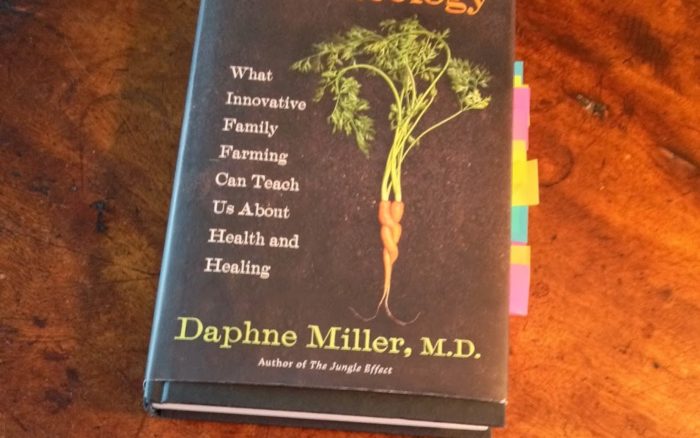| My own copy, full of post-it markers. |
Review: Farmacology: What Innovative Family Farming Can Teach Us About Health and Healing
Daphne Miller’s most recent book, Farmacology: What Innovative Family Farming Can Teach Us About Health and Healing (William Morrow, imprint of Harper Collins Publishers, 2013), opens with a visit to Wendell Berry’s home and his quote:
While we live our bodies are moving particles of the earth, joined inextricably both to the soil and to the bodies of other living creatures. It is hardly surprising, then, that there should be some profound resemblances between our treatment of our bodies and our treatment of the earth (The Unsettling of America).
As a Biodynamic farmer and Jungian analyst, I was immediately captivated, reading the entire book in two settings. Healing the soil and healing the psyche (including body) are two of my life quests as well, and this book added to my knowledge and resolve around both. Miller is at once an engaging storyteller and a curious, caring physician who can think out there on the edges where the creative stuff happens.
The book is a recounting of her visits to several farmers and medical researchers in her search for questions of what makes animals, plants, and soil thrive— or not— and the connection between these practices and human health.
Through the course of her substantive and entertaining journey, she demonstrates that as we grow more distant from the earth, we grow less healthy. When we treat the earth as a summation of its parts (as we have also done in medicine with our bodies over the last 200 years), the earth becomes less fertile and our bodies more depleted. A return to a consciousness of the implications that our bodies are earth can bring renewed vitality. Quoting aromatic plant distiller Evan Healy, Miller writes, “We are a mediating influence between terra firma and the cosmos, born to receive and diffuse aromatic molecules.” I am reminded here of Rudolf Steiner’s viewing the farmer as quintessential. In this attitude lies hope of healing our planet and ourselves.
There are practical suggestions as simple as don’t wash your farm fresh vegetables too much, dirt is good for you! (given it’s biodynamic or organic dirt, I might add!) The soil needs a diversity of microorganisms to be healthy, and as it turns out, we humans do as well. Or the uses of herbs and hydrosols (essence or vitality of the whole plant) in treating skin and other conditions.The wholeness of the plant seems to resonate with a restoration of wholeness in the human using it, a definition of healing.
In chapter “Heartland Egg and Arkansas Egg” Miller studies parallels in stress in chicken farming and stress in humans, introducing us to the term “allostasis,” or achieving stability through change. Stress is present all the time, but when there is allostatic overload, many systems are affected, including parts of the brain dealing with memory, learning, and fear, triggering auto-immune reactions and inflammation, and disease. This happens in chickens and it happens in humans, and Miller uses the research on chickens in her suggestions on how to deal with stress.
For me one of the more surprising chapters was “Scribe Winery.” Many of us growers are using insectaries and plant diversity to bring balance to our ranches and farming, decreasing or eliminating the need for chemical controls of various pests. Miller discovers how this principle is being applied to cutting edge cancer treatment, in which the “killing of anything not normal” is questioned. Instead, the whole, healthy organism is supported, one capable, perhaps, of keeping cancer cells in balance.
There is much to chew on in this book (no pun intended). Miller is presenting a paradigm shift in medicine and in farming.
To be healthy, you have to love the place you live, she writes. Her approach to the land and to her human patients is one which we Jungians would term feminine. It is defined by the questions Wendell Berry proposes in the beginning of her journey and his directive derived from poet Alexander Pope to “consult the genius of a place,” by asking “What was here when you came? What was here before you came? What was here for you to start with? What does nature require of you here? What will nature help you to do here?”
These questions, explored in each of the farms Miller visited as well as with her patients, reflect the attitude that can restore our relationship with the earth, the health of the soils, and the health of our bodies as well. They are of one piece.
Miller’s work is engaging and the reader finishes with resolve to listen, to love these bodies and this earth with which we have been blessed, and to adopt simple, concrete practices in eating and living to that end.
